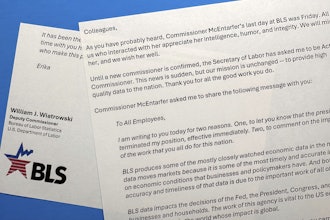
 SAP
SAPSome gaps are welcome — a gap between your house and your noisy neighbors, for instance, can be a great thing. But the nation's job gap? Not so much. Today, we have more than 350,000 manufacturing job openings across the nation, and people simply aren’t clamoring to fill them. Just ask the dismayed 56 percent of supply chain execs who lack qualified staff.
With Millennials — the first generation to reach adulthood around the turn of the 21st century — eschewing manufacturing sector jobs, Baby Boomers transferring to other industries, and Generation Xers nearing retirement age, trades-based companies face a serious challenge in filling key positions. It's a problem that has already impacted many manufacturers. When companies struggle to find the right candidates, innovation suffers, and critical projects get postponed. Firms can find themselves frustratingly moored to the status quo.
How Manufacturing Got Here
Manufacturing has been America's lifeblood for longer than even your grandfather could remember. So how on earth did we end up losing the momentum that helped make our country what it is today?
It’s a story that begins 20 years ago. When Millennials were coming of age in the late 1990s and 2000s, nationwide support of manufacturing was tapering off. The process came to a head with dramatic layoffs, which eventually led to the closing down of many trade schools. Accordingly, high schools began to focus on pushing students toward two-year and four-year academic institutions, leading many people who might be interested in manufacturing and supply chain careers to turn their sights elsewhere.
At first, this trend away from manufacturing didn’t make much difference: Many manufacturers heading offshore closed their doors anyway, so why did it matter if we weren’t training people for positions that were evaporating?
Now, the economic train that sent away all the manufacturing employment opportunities has returned. This renewed vigor and interest in manufacturing has significantly upped demand for talent. In fact, more than 3 million American jobs in the manufacturing industry are expected to be in demand by 2025. Yet the talent pipeline isn’t producing enough people to fill the anticipated need.
The answer? Instead of lamenting the future, industrial-based companies should focus on how to attract younger workers. In many cases, this means making some drastic changes to both culture and work environment. The good thing about making changes is that they won't only be alluring to Millennials and Generation Z — the 60 million young adults who came after Millennials. The changes will catch the attention of talented workers of all ages who want to work for a progressive company.
It all starts with a few strategic steps:
No. 1 - Take a hint from 'Dirty Jobs'
Although the popular TV show “Dirty Jobs” is no longer on the air, it completely transformed the way viewers thought about blue-collar employment. Host Mike Rowe showed the variety and excitement of the trades and tackled fact versus fiction within the industry. Similarly, manufacturers need to change the perception that manufacturing jobs are unpleasant, dangerous, and insecure. How? Start with outreach programs that connect your company with nearby high schools so future job candidates can get a taste of contemporary manufacturing before deciding on a career path.
No. 2 - Highlight technology
Millennials and Generation Z members are comfortable with innovation and technology. Consequently, they’re actively seeking employment that allows them to use their natural skill sets in these areas. Never assume that these up-and-coming talented workers understand just how technical the manufacturing landscape has become — many manufacturing entities could give top tech giants a run for their money. Job seekers need to realize how growth-focused and forward-thinking manufacturers are, and that requires public relations campaigns from manufacturing associations and the manufacturers themselves.
No. 3 - Emphasize environmental stewardship
Those under 35 repeatedly say they want to contribute to corporate cultures that give back and take care of natural resources in a sustainable manner. Many mistakenly assume that manufacturers don't care about sustainability. Nothing could be further from the truth. As a matter of fact, many manufacturers have made being good corporate citizens part of their charters. More prolific reporting of environmental and social initiatives — and their outcomes — will fuel a deeper recognition of how manufacturers are contributing to their neighborhoods, states, and world. That will start to change the narrative for earth friendly younger workers.
No. 4 - Cultivate talent through training
On-the-job training and apprenticeships need to move to the front seat if manufacturers want younger staff members on their teams. Young professionals value education in all its forms, from mentorships to on-site classes taught by company experts. Engagement programs will boost employees’ natural curiosity and encourage motivation — all while removing the stigma too often associated with getting into the field of manufacturing.
Throughout history, manufacturers have played an important role in the development of our nation. Now they are poised to help our economy move to the next level. What they need is the help of the next generations of workers to strengthen their numbers and keep them on the cusp of innovation. Millennials and Gen Zers who take the plunge into the manufacturing realm might just be surprised at how leading-edge it is — but it's up to the manufacturers to make the necessary changes to attract them.
Bob La Loggia is the founder and CEO of AppointmentPlus.






















